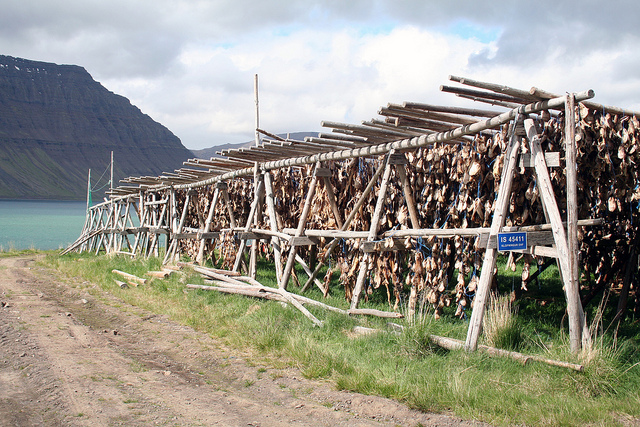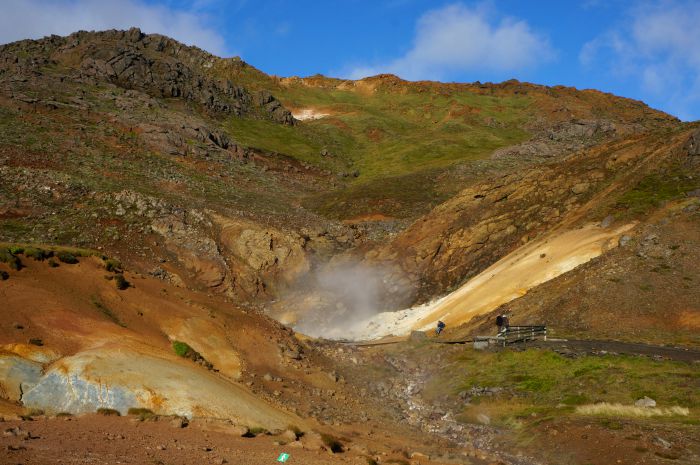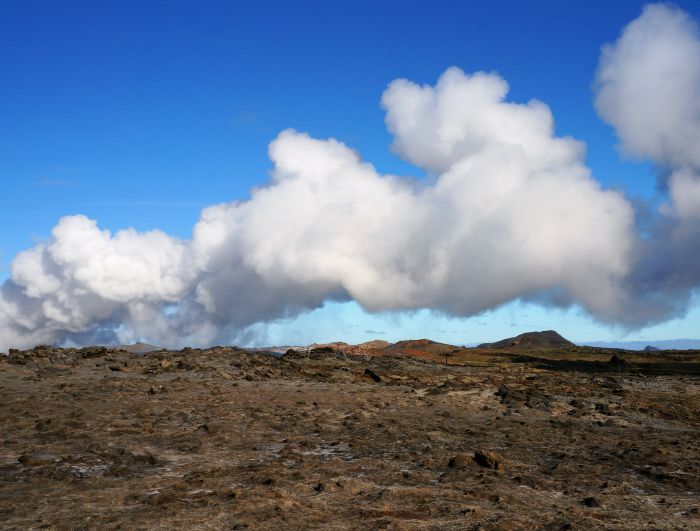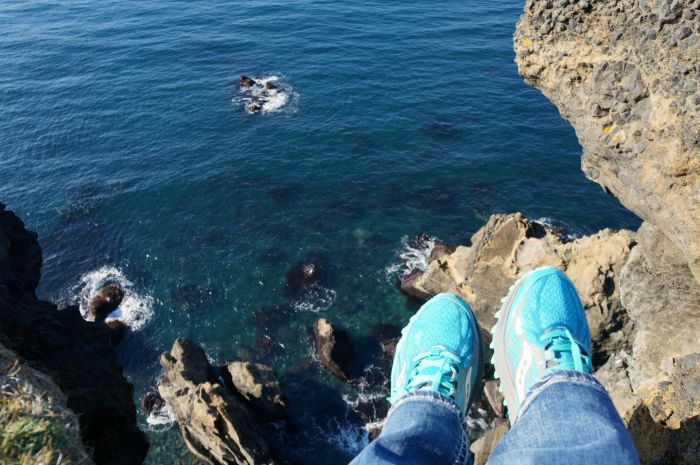The Golden Circle is a go-to for most tourists in Reykjavik, and with good reason — the tour features some of the area’s most impressive sights. But if you’ve already completed the Golden Circle and still have time to spare, you’ll quickly find that you have only scratched the surface.
Since we had a full day before our flight back, David spent our last night at the B&B curled up with his Sony tablet playing a game of “FIND SOMETHING INTERESTING”. We aren’t museum people and we didn’t want to waste a day.
The drive he created quite literally blew my mind and proved that together we make a pretty phenomenal travel team! I can handle the ideas, the upfront details and then he is supremely happy to play with maps for hours to figure out driving and interesting sites.  After another leisurely run and breakfast, we packed up the Yaris and started a breath taking drive to many places that weren’t listed in any tour or guidebook (and a few that were):
After another leisurely run and breakfast, we packed up the Yaris and started a breath taking drive to many places that weren’t listed in any tour or guidebook (and a few that were):
Dried Fish Racks
I missed stopping to get a photo (there aren’t exactly turn around spots on these cliff side roads), so you’ll have to do with a stock photo here, but suffice to say it was cool to see! The air drying of food is one of the oldest methods of preserving food in the world, and dried fish has a storage life of several years. Dried fish has been a staple food of the Icelanders for centuries and it is mentioned frequently in Icelandic tales.

Seltún Geothermal Area
When David mentioned another geothermal area, I though if you’ve seen one you’ve seen them all right?? Well not really, this one is a high-temperature geothermal area spanned by a boardwalk, Seltún features a variety of colorful displays made possible by depositedminerals from geothermal solutions.
The area is also home to several solfataras (shallow volcanic craters), fumaroles (openings in the planet’s crust that emit gas and steam) and boiling mud pots. Seltún was once intended for use as a drilling center, but mining efforts were eventually abandoned.

Gunnuhver Hot Springs
By far and away the smelliest of our stops as the piping water was billowing so much heat in to the air I was convinced we were driving up to a factory! In fact, I pulled my hood up as we started walking because the steam was so thick I was certain my hair would smell like eggs the rest of the day. Again I was glad we stopped because seeing the massive boiling water spot that in fact piped directly in to their nearby power plant was amazing.
Again I was glad we stopped because seeing the massive boiling water spot that in fact piped directly in to their nearby power plant was amazing.
The steam vents and mud pools known as Gunnuhver have all the appeal of Reykjavik’s better-known springs and none of the crowds. Sulphuric vapor brings a slightly eerie feel to the hot springs, as does the sign regaling the story of Gunna, the witch believed responsible for the creation of the geothermal area. 
Reykjanesviti Lighthouse
This is actually located right next to the Hot Spring, which means with one stop you can catch the both and more importantly it leads to my next tip… the cliffs!! So let’s be honest we gave this cute lighthouse a passing wave on our way to the vistas.
Reykjavik is typically associated with geothermal attractions, but the area surrounding the city also boasts a number of impressive lighthouses. Reykjanesviti is especially worth visiting, as it is Iceland’s oldest lighthouse. The original Reykjanesviti Lighthouse was built in 1878 and then destroyed in an earthquake less than a decade later. The current lighthouse was constructed in 1907 on the far safer Bæjarfell hill.
Reykjanes Cliffs
I wish I had a name for you here, but all I really know is they were the most beautiful site. If you can’t make it to the South side of Iceland (we didn’t) this is the next best thing to experiencing the magnificent ocean cliffs.  As always it was a combo of staring in to the crystal clear waters hundreds of feet below, seeing the black boulder beaches to the right, more stunning cliffs to the left and then turning around to see nothing but lava fields leading to the lighthouse and hot springs!
As always it was a combo of staring in to the crystal clear waters hundreds of feet below, seeing the black boulder beaches to the right, more stunning cliffs to the left and then turning around to see nothing but lava fields leading to the lighthouse and hot springs!
Iceland is a 360 view of awesome at all times.
Sandvik Beach
An expansive beach perhaps best known as the site of Iwo Jima in Clint Eastwood’s Flags of Our Fathers, Sandvik is a surprisingly popular surfing destination. Those not daring enough to explore the surrounding waters on surfboards can still marvel at the waves from the comfort of the shore.
BUT to get there you need to be willing to drive down a serious off road. Our Yaris made it to the first water crossing and well if you remember our hiking story (read it) we decided not to join the ranks of the “stupid tourist” and turned around. Luckily our very next stop, still allowed us to see the black sand!
”If Share on XBridge Between the Continents
Designed to mark the connection between Europe and America, the Bridge Between the Continents (or, as it is sometimes called, Leif the Lucky Bridge) is a small footbridge from which visitors can look down and see the fissure formed by two diverging tectonic plates.  Nothing out of this world here, it’s literally just the bridge…but D was still very excited to see it and hey we crossed black sand off the list, while getting our final selife of the trip!
Nothing out of this world here, it’s literally just the bridge…but D was still very excited to see it and hey we crossed black sand off the list, while getting our final selife of the trip! 
Unfortunately we ran out of time to stop at these last few spots, but instead did a quick drive by and noted them as “things we will see next time!!”
Keflavík Stone Trolls
From the Silent Sentinels to the Traveling Twins, the stone trolls of Keflavik have picked up a number of monikers over the years. No matter what they are called, these stone structures make for an excellent photo opportunity, as they overlook the ocean and are centered around a convenient viewing platform.
Keflavik Stekkjarkot Turf Houses
Turf houses known as Stekkjarkot were very common in Iceland between the 17th and the 19th centuries. Constructed from turf, stone and timber, these structures were typically inhabited by the families of fishermen. In Keflavik, one of these turf homes has been reconstructed and is now open to the public. Inside the home is a open hearth built sometime during the 19th century.
The Giantess in the Mountain
Icelandic children’s author Herdis Egilsdottir has writen over a dozen books about a giantess and her human friend, Sigga. The giantess from these tales is portrayed in a large sculpture that sits in a rocking chair at the edge of the Keflavik Marina. Her cave home features an array of giant-sized furniture, including a bed, chairs and a table. The giantess can often be heard snoring in her sleep and making other unflattering, yet amusing noises.
Are you a museum or nature person?
Have you rented a car in a foreign country?
Other ways to connect with Amanda
Instagram: RunToTheFinish
Facebook: RunToTheFinish
Get new posts via BlogLovin



 Driving the Golden Circle: Thingvellir National Park
Driving the Golden Circle: Thingvellir National Park
